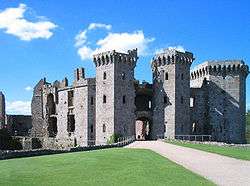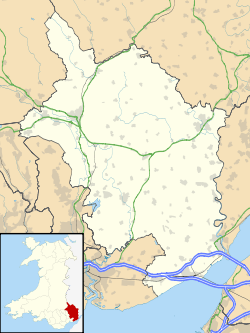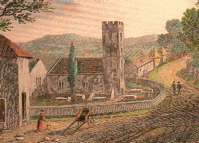Raglan, Monmouthshire
Raglan (Welsh: Rhaglan) is a village and community in Monmouthshire, south east Wales, United Kingdom. It is located some 9 miles south-west of Monmouth, midway between Monmouth and Abergavenny on the A40 road very near to the junction with the A449 road. The fame of the village derives from its castle, Raglan Castle, built for William ap Thomas and now maintained by Cadw. The community includes the villages of Llandenny and Pen-y-clawdd. Raglan itself has a population of 1,183. [2]
Raglan
| |
|---|---|
 Raglan Castle from the front, with main gatehouse at the centre | |
 Raglan Location within Monmouthshire | |
| Population | 1,928 (2011)[1] |
| OS grid reference | SO413077 |
| Principal area | |
| Ceremonial county | |
| Country | Wales |
| Sovereign state | United Kingdom |
| Post town | USK |
| Postcode district | NP15 |
| Dialling code | 01291 |
| Police | Gwent |
| Fire | South Wales |
| Ambulance | Welsh |
| UK Parliament | |
History and buildings
The village stands at the crossing point of two Roman roads, that from Gloucester to Usk, and that from Chepstow to Abergavenny.[3] The origins of the village are unknown but Raglan was first mentioned in the will of Walter de Clare.[4]
The earliest market in Raglan was recorded in 1354.[5] The market cross in the town, which stands in the centre of the cross roads between the church and the Beaufort Arms Inn, consists now only of a massive base on which has been mounted a lamp post. In the large space around this stone the markets were held, the base of the cross forming the table on which bargains were struck.[4]
The agricultural roots of Raglan are illustrated by a 1397 account between the ‘reevem’ or reeve Ieuan Hire and Ieuan ap Grono and haywards (hedge wardens) Iorwerth ap Gwillym and Hoe ap Gwillym Goch.[6]
The earliest records of the manor of Raglan Court are found in 26 October – 28 July 1391 during the reign of Richard II.[7] At this time Raglan Castle was probably no more than a hill fort. After 1415 Raglan Castle was greatly expanded.
Records from 1587 refer to Raglan as a town. For the court, 13 July 1587, the marginal heading reads Burgus de Ragland cum Curia Manerii de Ragland cum membris and the caption becomes 'The Court of William Somerset, 3rd Earl of Worcester of his said borough and the Court of the said Earl of his said manor with members'. From 1 June 1587 onwards most courts refer to the Borough of Ragland in the following manner: 'The Court of the said manor with the Court of the borough or the town of Ragland'.[8]
By 1632, a Court House was established in Raglan. "The jury to meet at the Court House at Ragland the 25th March next by ten of the clock under peyn of xls. apeece to have a view and inquire of lands in Landenny (Llandenny) and Ragland late of Philip David Morris", (Dec. 1632).[8] Subsequent leet courts refer to the liberty of Raglan and in 1682 the hundred of Ragland is mentioned. Court Roll excerpts reflect the issues of the day: In 1680, ‘The bridge called Pontleecke upon the highway leading from Raglan towards Chepstow to be out of repair. Moses Morgan fined for not spending 14s of the parish money towards repairing the stocks and whipping post in the parish of Raglan’. In 1695 the repair of bridges are still under discussion, ‘The bridge called Pont y bonehouse in the town of Raglan, 1695. John Curre, gent., steward’.[9]
There is no longer a direct train service to the village, the local railway station having closed in 1955. The railway station buildings have been removed to St Fagans.[10] The village continued to be an important thoroughfare in the 18th and 19th centuries, which explains its three substantial coaching inns the Beaufort Arms, the Ship and the Crown where the mail coaches would stop.[11]
Raglan Castle
The English Civil War had disastrous consequences both for Raglan Castle as well as for Raglan village. Raglan Castle was besieged for two months from 3 June to 19 August 1646 by Parliamentarian forces. The Castle finally surrendered to Thomas Morgan, when Sir Thomas Fairfax arrived with 3,500 men and six deadly mortars. ‘The house almost starved … had like to have eaten one another’ was the report and the Parliamentarians called in the local people to help demolish the Marquess's home.[12]
The link between castle and village was severed. The castle ruins became neglected and were used as a quarry for those needing stone to repair their houses: dressed and moulded stones can be seen in farmhouses and cottages in the area. The castle is now maintained by Cadw, although the Duke of Beaufort remains the hereditary keeper of the castle.
St Cadoc's Church

St Cadoc's is a substantial mediaeval church, extensively restored in the 19th century by Thomas Henry Wyatt. It houses some much-defaced tombs of the Lords of Raglan. The base of a fine pilgrim's cross can be seen in the churchyard. The first part of the church was built during the 14th century.
Governance
Raglan elects a community council of ten community councillors.[16]
St Mary's is also a county electoral ward for elections to Monmouthshire County Council, represented by one county councillor.[17]
Notes
- "Community and Ward populations 2011". Retrieved 4 April 2015.
- https://www.nomisweb.co.uk/reports/localarea?compare=W37000322
- Soulsby 1983, pp. 222-3.
- Bradney 1992, p. 2.
- 'Wales', Gazetteer of Markets and Fairs in England and Wales to 1516 (2005). URL: http://www.british-history.ac.uk/report.asp?compid=40533. Date accessed: 24 March 2007.
- Badminton records: No. 1,573. Michaelmas, 21 Richard II to Michaelmas, 22 Richard II (1397 to 1398. National Library of Wales.
- Bad1am3.doc National Library of Wales.
- Badminton Records. 13 Oct. 1587 (MS 8); MS 7 National Library of Wales.
- Court Roll, 4 August 1716, National Library of Wales
- "Raglan railway station to move to St Fagans museum - BBC News". Bbc.co.uk. Retrieved 5 April 2017.
- Newman 2000, p. 489.
- Kinross 1973, p. ?.
- "Cross at Croes Lwyd, Raglan" at britishlistedbuildings.co.uk
- "CROES LLWYD" at coflein.gov.uk
- "Cross on Croes Lwyd Farm, Monmouthshire" at ancientmonuments.info
- "Councillors". Raglan Community Council. Retrieved 13 January 2019.
- The County of Monmouthshire (Electoral Changes) Order 2002. legislation.gov.uk. Statutory Instruments. 6 December 2002. Retrieved 13 January 2019.
References
- Bradney, Joseph (1992). A History of Monmouthshire: The Hundred of Raglan, Volume 2 Part 1. Academy Books. ISBN 1-873361-15-7.
- Kinross, John (1973). Discovering Castles in England and Wales. Shire Publications.
- Newman, John (2000). Gwent/Monmouthshire. The Buildings of Wales. London: Penguin. ISBN 0-14-071053-1.
- Soulsby, Ian (1983). The Towns of Medieval Wales: A Study of Their History, Archaeology, and Early Topography. Chichester: Phillimore. ISBN 978-085033-437-1.
External links
| Wikimedia Commons has media related to Raglan, Monmouthshire. |
| Wikivoyage has a travel guide for Raglan, Monmouthshire. |